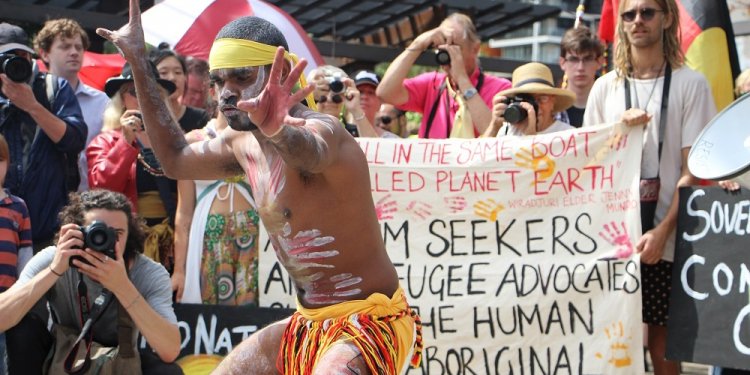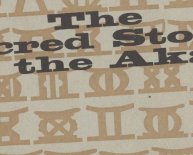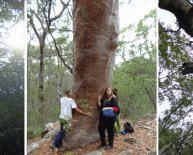
Aborigines of Australia
![]() Warning. Australian Stories may contain the names and images of Aboriginal and Torres Strait Islander people now deceased. Australian Stories also contain links to sites that may use images of Aboriginal and Islander people now deceased.
Warning. Australian Stories may contain the names and images of Aboriginal and Torres Strait Islander people now deceased. Australian Stories also contain links to sites that may use images of Aboriginal and Islander people now deceased.
With mounting evidence and stories circulating about their seemingly miraculous ability to find people, Aboriginal trackers' abilities became legendary in the minds of white Australians. To the British people who had arrived in Australia after its establishment as a British colony in 1788, who were unfamiliar with the Australian landscape, these skills were remarkable and seemed almost magical.
The first recorded use of Aboriginal trackers in Australia took place in 1834 in Western Australia, near Fremantle, when two trackers, Mogo and Mollydobbin tracked a missing five-year-old boy for more than ten hours in very rough country. In 1864, the Duff children were lost for nine days in the Victorian Wimmera and the community was hampered in the search by heavy rain. Within a day of 'black trackers' being brought in, the Duff children were found, and amazingly, still alive.
Tracking skills
Paul Raffaele, Aboriginal tracker Teddy Egan and son. Image courtesy of Paul Raffaele.
 Aboriginal people have developed exceptional tracking skills based on their hunter and gather life which includes the ability to track down animals, to identify and locate edible plants, and to find sources of water.
Aboriginal people have developed exceptional tracking skills based on their hunter and gather life which includes the ability to track down animals, to identify and locate edible plants, and to find sources of water.
Indigenous Australian children learn to recognise the tracks of animals as soon as they are old enough to notice. Traditionally, as soon as children learn to walk, they learn to track their mother's and sibling's footprints as well as learning hand signs so people know when to be quiet or careful. To this end, people walking together in the bush do so in single file. The ground also makes a good drawing board and children learn the patterns and shapes which represent the tracks of common animals.
An experienced tracker can read the ground like a storybook. If the tracks are those of a mammal, he can probably tell you, from the size and 'weight' or depth of the tracks, its gender and approximate age. If the animal is a female, he will know by the spacing of the hind legs whether or not it is 'parapu' (carrying young). He will usually be able to tell you the species of a lizard and not only which way a snake is travelling, and its size, but how fast it is moving and whether it is harmless or venomous.
Pat Lowe, Hunters and trackers of the Australian desert, 2002
S. Sadler, Emu tracks (Dromaius novaehollandiae) in the Gibson Desert, Western Australia. Image courtesy of DW Stock Picture Library.
Trackers also need to know whether tracks are fresh, otherwise they might be wasting their hunting time. At the end of a day, however, a good hunter needs to be able to find his way home using the shortest route possible - not in the tedious zigzag way he tracked his prey. This acute sense of direction is inseparable from acute powers of observation and good memory.
Aboriginal guides in colonial exploring expeditions
The Aborigine Piper, who accompanied Mitchell on his expeditions. Lithograph by Fernyhough, Sydney, c. 1836. Image courtesy of the State Library of New South Wales.
![]() As more and more European settlers came to the new British colony, the demand for land for farming and housing became greater. To meet the demand, some British settlers became explorers and it was common for such groups to include Aboriginal people as guides. The guides would use their knowledge of the land and their tracking skills to lead the party through unfamiliar country, find horses and party members who had strayed, and locate food and water.
As more and more European settlers came to the new British colony, the demand for land for farming and housing became greater. To meet the demand, some British settlers became explorers and it was common for such groups to include Aboriginal people as guides. The guides would use their knowledge of the land and their tracking skills to lead the party through unfamiliar country, find horses and party members who had strayed, and locate food and water.
The Aboriginal guides would also take on a diplomatic roles. They acted as ambassadors for the travellers as they passed through different tribal areas and making the group's passage as peaceful as possible, sometimes handing over their responsibilities at tribal border areas.
Explorers who worked with Aboriginal guides as part of their expeditions included Major Mitchell, who relied on the services of the Bathurst man known to the party as 'John Piper' to cross the Great Dividing Range.
Another well-known explorer was Edward John Eyre (1815-1901) who, together with his Aboriginal friend Wylie, was the first man to cross southern Australia from east to west, travelling across the Nullarbor Plain from Adelaide to Albany.About 1000 km short of Albany, Eyre and Wylie survived near starvation after seven days by finding a native waterhole and killing and eating kangaroos. Wylie was rewarded with a pension and returned to his country in Albany.
In contrast, the party led by Robert Burke and William Wills, from Melbourne to the Gulf of Carpentaria in Australia's far north, did not include Aboriginal guides. The account from the sole survivor, John King, records the explorers' hostility at offers to trade food for handkerchiefs from Aborigines along the Darling River. Oral history from Aboriginal descendents records the horror of the tribespeople at the expedition's caravan of oxen, bullocks, camels and horses drinking waterholes dry and removing all the heavy grinding stones from camp sites. Both the leaders of the expedition, and many others, died on this ill-fated expedition.
The Native Police forces
By the early 1800s, Aboriginal guides were also used to track down convicts and other criminals who had escaped into the bush, known as 'bushrangers'. It was a natural progression to use Aboriginal guides to track down Aboriginal people as well.
W.S. Smith, Horsemen including blacktrackers. Image courtesy of the State Library of New South Wales.
The first experiments with Native Police commenced in Victoria in 1837. In 1842, the Port Phillip Native Police Corps was established. The Corps included white officers and black troopers. The Corps provided a deterrent to Aboriginal attacks on pastoral properties as well as later policing the gold diggings and escorting gold to Melbourne.
















